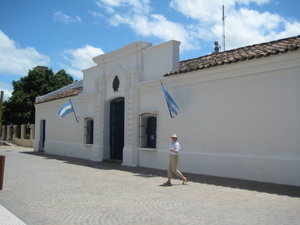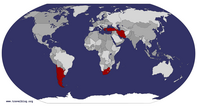Advertisement
Published: January 24th 2010

 The Casa Historico, Tucuman
The Casa Historico, Tucuman
Where the first constitution was signed in 1816Sunday 27 December: Tucuman
We arrived in Tucuman feeling pretty good considering that we had been on the bus for 13 hours overnight from Mendoza. I had spent the last couple of hours looking out of the window, initially at the rain and thankfully at blue skies by the time we arrived.
We had a breakfast of coffee and medialunas at the bus station before going in search of our hotel, thankfully it had air conditioning. We thought it had been hot before but Tucuman really was hot. Being the Sunday after Christmas the city centre was fairly empty with nearly everything closed.
We wandered around for a while looking at the outside of some closed museums, tracked down the town centre cinemas which had either closed down - or now showed programming suitable for over 18s that probably didn't need subtitles.
We went into the Casa Historico, a really well restored 18th century town house around courtyards. This was where the declaration of independence was signed in July 1816 and includes portraits, maps and artefacts. worth a visit and is free on Sundays. Later we decided to walk out to the enormous Parque Nueve de Julio only a few blocks
from the town centre to see the sugar mill, now the Museo de la Industria Azuracena. The park was full of people having their afternoon fun, sitting under trees drinking mate or running around despite the heat.
When we went out in the evening we found lots of people at a peace concert in the square. We left them to it and went for steak and wine....just for a change.
Monday 28 December: to Andalgala
After a bit of a false start we managed to pick up our hire car, a VW Gol (I sure there is a joke somewhere about no F in Gol but perhaps another day), and started off by driving south out of Tucuman. First stop was quite close to the city at Lules where we stopped to look at the ruins of the jesuit foundation and church. We then headed south through sugar and tobacco plantations on the main road to Catamarca before turning off at Concepcion aiming for Andalgala. This was number 73 in our book on the 100 best places to see in Argentina and it sounded like the scenery was spectacular hence it made it onto our itinerary.
Our Footprint
Guide showed that the road to Andalgala was tarmac and when I had 'phoned the hotel in Andalgala they thought it was a 2 to 3 hour drive from Tucuman. However the reality was rather different: the paved road ran out about 15km from Concepcion, just before the rusty sign that indicated Andalgala was 93km and that the route was "sinuosa".
The first climb was up a reasonable ripio and earth road that climbed through a lush landscape with occasional views down across the flatlands . This was followed by a steady descent into a wide bowl surrounded by mountains. We came across a couple of resort hotels a long way from nowhere and a some small villages. After a while I thought we must be nearing the end of the trip, Susan dozed off.
But at this point we came round a bend and suddenly realised that we had reached a version of the edge of the world. My expletive woke Susan up. This was the start of the Cuesta de Chilca a descent down a piece of rocky road clinging to a cliffside. Think of a cartoon cliff and road and one of those occasions where
you can see the road at the bottom from the top and it was a heck of a long way down. It would have been good to stop and take a picture or two but I was fighting off an attack of vertigo!
Eventually we did reach the bottom and drove the last 20 km or so into Andalgala, arriving some 5 and a half hours after leaving Tucuman. Bizarrely the last couple of km were on smooth tarmac. We had no map of the town to help us find the hotel and the streets were empty so we made our way to the town square and found the tourist office and asked them in our best castellano for directions, they happily provided us a series of maps and leaflets and had a good debate amongst themselves about the directions to send us in. We picked the gist and stepped outside and looked at the town map where the hotel was clearly marked. We pitched up at the Hotel Aquasol to find it had a huge outdoor swimming pool and this was where the locals were enjoying themselves. We had a different idea: first priority was a cold beer.
Enjoyed by the pool reading our new tourist leaflets about the delights of Andalgala - this didn't take too long and probably explained why there is almost no mention of the place in the guidebooks.
Whilst it was a relief to have got to Andalgala after the travails of the day we knew that tomorrow could be more of the same. We had three choices to get to the road north to Cafayate: go back the way we had come and come back over the hills via Tafi del Valle (this was not seriously considered) or to go on a rough (really rough) road via Mina Capillitas or on a rough road to Belen. The mine road went up to over 3,000 metres and sounded like it was only suitable for a proper 4x4 pickup, not our nearly new Gol 1.6. We put these thoughts to one side when we joined the locals to spend the evening in the plaza. The heat of the day barely subsiding. Back at the hotel we rearranged our large room to put the bed under the ceiling fan and left that running all night.
Tuesday 29 December: to Cafayate
After a frugal
breakfast of coffee, facturas and jam we went shopping to get some supplies for the day in case it was anything like yesterday: fruit juice, water and crackers. At the local petrol station I asked the attendant about the road to Belen he told me it was Ok and that the Gol would be fine. We left Andalgala thinking that, yes the scenery en route was something else, we probably would not put it in our 100 places to visit guide. But at least we would no longer have to wonder about what it was like!
Off we went, the road ran straight as an arrow towards the distant hills blurring in the heat. This was a different sort of ripio, with occasional soft sandy patches to break up the combination of earth and rock but eventually we came to the hills expecting to climb over them and found that the road turned south and ran parallel for a good half an hour before climbing over the Cuesta de Belen. This was scenic and perhaps if we hadn't had yesterday's experiences it might have been exhilarating but it was short and the drops were only in the 10s of
metres not the 100s and 1000s. We came down onto the Belen side of the range to find ourselves diverted off the ripio onto a newly bulldozed track across the scrub - roadworks were being done but no-one working: just like home.
90km, and about two hours, from Andalgala, we reached Belen, a town we had previously visited in December 2007, it's small and remote but we had fond memories of one of its restaurants so we decided to go there for lunch. The same staff were there and we were served by the waiter who has the party trick of dressing your salad for you at the table (he even has a mention in Lonely Planet). After a very pleasant couple of hours relaxing we headed north on R40. Since our last visit the road gangs have finished tarmacing the road nearly all the way to Hualfin so the 250km to Cafayate wasn't too bad. After we passed Santa Maria we even managed to find a radio station that was playing Chacarera folklorico. We made it into Cafayate before the rain and we watched some spectacular lightning displays on the hills all around. In Cafayate we stayed in
the same hotel as last time we were here and ended up in the same room. After the thunderstorm we went to a local restaurant to have a parillada and a bottle of local red.
Wednesday 30 December: Quilmes to Salta
Part of the reason for coming back to this part of Argentina had been to visit the Diaguita ruins at Quilmes, these had been closed two years ago in a land dispute. The plan was to visit these today, they were about 60km back down the road to Belen but I woke up feeling tired and thinking about the day's driving. After two days with lots of tough driving I felt like a quiet day and dared to suggest that we might visit Quilmes "another day" . Susan's response after a couple of minutes was along the lines of "that's rubbish. We are going today, get in the shower" . I heard and obeyed. I think some of her colleagues would recognise the tone (?). So after hot water and a couple of cups of coffee we were on the road to Quilmes.
We arrived at the ruins to find that they were open but that the

 Looking south at Quilmes
Looking south at Quilmes
Mortars for grinding corngift shop, confiteria and parador were closed down and looked like they were victims of the land dispute. We spent a happy couple of hours scrambling around the ruins and felt really pleased at having made the effort.
Back in Cafayate we stopped for some empanadas and a trip to the wine shop before driving through the lovely Quebrada de las Conchas on the way to Salta. Some three hours or so later we reached the city. Salta is a city we know well so we dropped off the bags at our hotel and went for a walk to see what might have changed and to see if there were any dance shows that we could go to: there weren't. The evening brought torrential warm rain that challenged our mini umbrellas as we made our way to the Plaza de 9 Julio to a cafe. More later
Advertisement
Tot: 0.042s; Tpl: 0.012s; cc: 12; qc: 24; dbt: 0.0224s; 1; m:domysql w:travelblog (10.17.0.13); sld: 1;
; mem: 1.1mb










